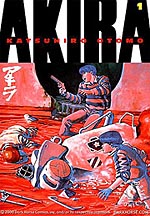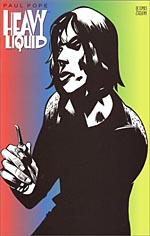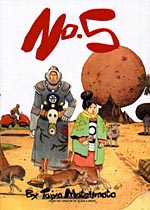
I'd always read science fiction as a kid, and figured it was just simple escapism. I never really realised that a lot of the writers were using SF motifs as a way to comment on society.
I think William Gibson was the first author to key me in to this fact. While Gibson began by watching kids slamming coins into arcade machines, writers before commented on more far-reaching topics. HG Wells used genetic engineering and a dying earth in the late 1890s in THE ISLAND OF DR MOREAU and THE TIME MACHINE, books that future generations will never read because of the bad film versions. The New Wave writers of the 60s like Michael Moorcock and M John Harrison used socio-political situations of the time in much of their work. John Brunner used the environment and overpopulation in books like THE SHEEP LOOK UP and STAND ON ZANZIBAR.
We sometimes forget that comics began as science fiction. That's what SUPERMAN is. He's even from another planet. And by the same token, comics have been influenced by what is happening in the world. CAPTAIN AMERICA and World War II. THE FANTASTIC FOUR and the mysteries of space. SPIDER-MAN and the HULK and the Nuclear Age. The science fiction motifs are there. They were science fiction before they were superheroes.
Luckily, there are also plenty of spandex-free, good old fashion SF comics to read.
 AKIRA (Dark Horse)
AKIRA (Dark Horse)
By Katsuhiro Otomo. Translated by Yoko Umezawa, Linda M York and Jo Duffy.
Vol 1: US$ 24.95 ISBN: 1-56971-498-3
Vol 2: US$ 24.95 ISBN: 1-56971-499-1
Vol 3: US$ 24.95. ISBN: 1-56971-525-4
Vol 4: US$ 27.95. ISBN: 1-56971-526-2
Vol 5: US$ 27.95. ISBN: 1-56971-527-0
Vol 6: US$ 29.95. ISBN: 1-56971-528-9
AKIRA opens with the destruction of Tokyo, a black hole at the centre of the explosion...
Kaneda and Tetsuo are childhood friends, cruising the streets of Neo-Tokyo, 38 years later, with their motorcycle gang, skipping school and engaging in gang warfare with their enemies, the Clowns. Tetsuo is the runt of the litter, so when he starts to develop psychic abilities after a run in with the military, he grabs hold of his new found, awesome psychokinesis with glee. What's the saying about absolute power?
This all sounds like a fairly standard SF plot: psychic abilities and a post-apocalyptic dystopia full of drugs, violence and sex. But creator Katsuhiro Otomo doesn't follow the tropes of tradition. Being a hormone-driven teenager, Kaneda instead stumbles onto the truth about Tetsuo, the mysterious Akira, and how he is linked to the destruction of old Tokyo, just by following a girl he fancies.
Akira has it all. Motorcycle gangs, ultraviolence, government conspiracies, the shadow of Hiroshima, and, of course, psychic children. This is one of comics' more epic SF stories, and Otomo's opus; six volumes, 2214 pages in total. It's one of those books (or in this case, six of them) that people say represents the finest comic work ever produced. And they're not wrong.
 HEAVY LIQUID (DC Vertigo)
HEAVY LIQUID (DC Vertigo)
By Paul Pope
US$ 29.95/CAN$ 49.95
ISBN: 1-56389-635-4
This slot should ideally go to Paul Pope's beautiful THB, especially as it's on my list as One Of The Best Comics Ever, but seeing as it's mostly out of print (although a collection has often been promised), his first Vertigo mini-series will have to do.
'S' is a Jack Kirby-esque figure on acid, a 21st Century Mick Jagger, former cop, current private eye, and an addict of a mysterious substance called Heavy Liquid. Gaylord Schmeltz, the enigmatic 'Collector', has hired him for two jobs: first, steal some of the mystery metal from crimeboss Linch-Pin; and second, find the world's best artist, Rodan Esperella. What started off a simple job has left S's best friend dead, and S himself on the run from three masked clowns, not to mention the man in the white hat. And, of course, like any good noir story, there is a twist involving a dame: the artist is the only woman to break S's heart.
Pope populates his story with his usual mix of strange multiple cultures, (including Three Loaves, the little pirate girl and her army of robots) and cool tech ('Lil' Fucker', is a particular favourite of mine). His love and knowledge of art is evident throughout the book. Kip, one of the three clowns, wears an 'Animatro'-brand Cubist mask, giving him a Picasso head. Pope's choice to use three hues in place of his usual black and white gives HEAVY LIQUID a unique look.
This is art nouveau sci-fi, more 'artpunk' than cyber, heartbreaking and breathtaking.
CHANNEL ZERO (AiT/PlanetLar)
By Brian Wood
US$ 12.95
ISBN: 0-9676847-4-9
The term 'science fiction' is stretching it when it comes to CHANNEL ZERO. So is 'social fiction'. Sometimes, it seems like 'fiction' sounds wrong. The hi-tech motifs of SF are there, as is the oppressive government, but this is artist/writer Brian Wood responding to what was happening around him in New York in the early 1990s. This is not some view of the future. This is now.
Jennie 2.5 is former art student turned self-styled media whore, armed with a video camera, a laptop, a city full of contacts and her anger. Her body is a canvas to her mission: barcodes and brands, black squares reminiscent of 'censored' labels. Jennie uses the media against itself and the government in her private broadcasts, fighting against the Clean Act imposed on the city, which bans anything deemed unwholesome. Cleaners, agents above the police, have a license to scour the streets looking for and eliminating dissidents. It's a place that's just a nudge to the right of our own.
CHANNEL ZERO is subversive and overt at the same time, a form of poetic terrorism hidden in the unassuming guise of a comic book. Tiny 'subvertisments' are littered throughout, telling the reader to consume, while CHANNEL ZERO-endorsed ads tell us to "MAKE THEM LISTEN". The world of CZ seems, at first, as starkly black and white as Wood's art; you're either with Jennie or against her. But, as we all know, the media eventually turns everything to its advantage.
 NO.5 (Viz Comics)
NO.5 (Viz Comics)
By Taiyo Matsumoto
US$ 15.95/CAN$ 26.50
ISBN: 1-56931-738-0
No. 5 is the fifth member of the Rainbow Council, an elite team of International Peacekeeping superhumans. No. 5 is the Council's greatest warrior, an expert sharpshooter with a really big sniper rifle. No. 5 has allegedly got a girl pregnant. No. 5 has disappeared with said girl.
The eight remaining members of the Rainbow Council are after him. And as the story opens, No. 5 kills No. 9 with a headshot. And No. 5 liked No. 9.
While the plot of Taiyo Matsumoto's beautifully bizarre NO. 5 is surprisingly simple, it's his images and concepts that elevate this book above anything else on the shelves. His art is reminiscent of Moebius, with a touch of Frank Miller circa RONIN. The panels move easily from squares and rectangles to lopsided Pythagorean spaces and thin angry triangles. The layouts project calm one minute - with Matroshka, the girl, eating M&Ms in an animal-populated valley while No. 5 tries to show her flowers - then breaks into kinetic and brutal action in the next, as No. 5 defeats yet another attempt on his life.
But it's the bizarre elements with which Matsumoto has populated his world that really amaze you: The brain behind the council is Papa. He's a genius. We know this because he wears glasses... and has the word GENIUS spelt down the front of his bunny suit. There are the obligatory psychic twins, and conspiracies. The world is, on the outside, an environmental utopia, everything fitting into the surroundings, even the Council's planes being shaped like wasps, right down the stripes on the thorax. It's the details that count.
FINDER (Lightspeed Press)
By Carla Speed McNeil
Volume 1: SIN-EATER
US$ 15.95
ISBN: 096736910X
The concept of family lies at the centre of the first FINDER book; family in blood and in spirit.
Emma Grosvenor and her children are living in the domed city of Anvard, hiding from her husband Brigham, member of the military Medawar clan, and a homicidal maniac.
Re-entering the Grosvenors' life is Jaeger, a member of a secret society known as Finders, who act as hunters, trackers and, often, much more. The 'more' in Jaeger's case is that he's also a Sin-Eater, one who takes the mortal sins of the dying onto himself, as well as, more or less, an unofficial member of the Grosvenor family, having served with Brigham in the military. And because of this, he owes Brigham. And for Jaeger, family appears to be the only tie that binds.
This summary really doesn't do Carla McNeil's vision justice. She uses Finder as a way to tell all the stories she's ever wanted, and from the details on the page to the extensively delightful annotations, you can tell this is a labour of love for her. Her characters and settings are like nothing else I've ever read; contemporary and familiar, yet utter alien at the same time. There are dozens of ideas on every page, mixed in with homages and tips-of-the-hat to her influences and friends. This is some of the best work being produced at the moment, regardless of whether you like science fiction or not.
Oh, and you'll notice the fact that this is just a summary of Volume One: buy the first two volumes in one go, though. You won't regret it.

This article is Ideological Freeware. The author grants permission for its reproduction and redistribution by private individuals on condition that the author and source of the article are clearly shown, no charge is made, and the whole article is reproduced intact, including this notice.


